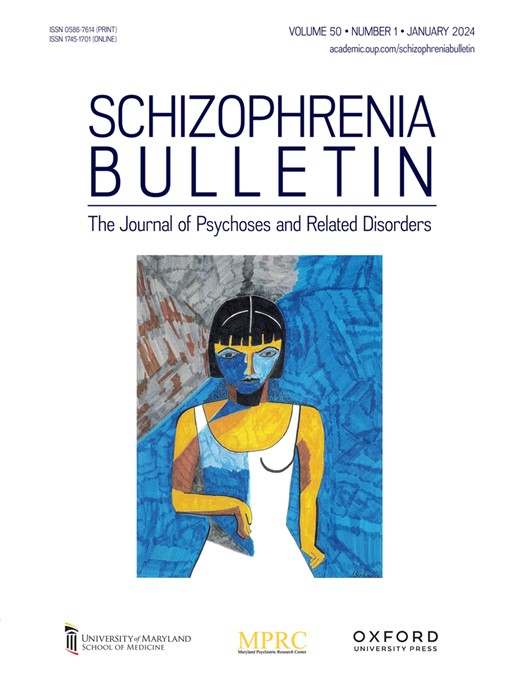洞察力及其轨迹:预测专科协调护理第一年内首发精神病患者的精神病住院风险
IF 5.3
1区 医学
Q1 PSYCHIATRY
引用次数: 0
摘要
本研究探讨了基线洞察如何预测186名首发精神病患者在协调专科护理(CSC)中的住院风险。我们假设,洞察力是一个潜在的可改变因素,调节了CSC入组和结果之间的关系,高基线和稳定的高洞察力预测住院和住院时间(LOS)的更大减少。设计洞察力采用正、负综合征量表的G12项进行评估,将参与者分为低(G12≥4;n = 87)或高(G12 <;4;N = 99)基线洞察组。确定了6种纵向轨迹:稳定高位(n = 48)、上升(n = 41)、下降(n = 31)、稳定低位(n = 27)、高-低-高(n = 20)和低-高-低(n = 19)。住院数据收集在csc入组前和入组后的12个月。结果基线洞察力高的参与者住院率相对降低95%(相对风险降低= 1.95,P = 0.002),表明洞察力调节了CSC入组和住院结果之间的关系。纵向上,稳定的高洞察力组的住院率下降幅度最大(风险比[RR] = 0.12, P <;0.001)和LOS (RR = 0.04, P <;.001),表现优于稳定的低水平和波动的洞察力组。结论Insight调节CSC入组与住院预后的关系,预测早期精神病患者的临床改善。针对洞察力的干预可以通过减少住院和改善康复轨迹来增强CSC的益处。本文章由计算机程序翻译,如有差异,请以英文原文为准。
Insight and Its Trajectory: Predicting the Risk of Psychiatric Hospitalizations Among First-Episode Psychosis During the First Year of Coordinated Specialty Care
Background This study explored how baseline insight predicts psychiatric hospitalization risk among 186 individuals with first-episode psychosis in coordinated specialty care (CSC). We hypothesized that insight, a potentially modifiable factor, moderates the relationship between CSC enrollment and outcomes, with a high baseline and stable high insight predicting greater reductions in hospitalizations and lengths of stay (LOS). Design Insight was assessed using the G12 item of the positive and negative syndrome scale, categorizing participants into low (G12 ≥ 4; n = 87) or high (G12 < 4; n = 99) insight groups at baseline. Six longitudinal trajectories were identified: stable high (n = 48), increasing (n = 41), declining (n = 31), stable low (n = 27), high-low-high (n = 20), and low-high-low (n = 19). Hospitalization data were collected for 12 months pre- and post-CSC enrollment. Results Participants with high baseline insight demonstrated a 95% greater relative reduction in hospitalizations (relative risk reduction = 1.95, P = .002), indicating that insight moderated the relationship between CSC enrollment and hospitalization outcomes. Longitudinally, the stable high insight group exhibited the most substantial reductions in hospitalizations (risk ratio [RR] = 0.12, P < .001) and LOS (RR = 0.04, P < .001), outperforming the stable low and fluctuating insight groups. Conclusion Insight moderates the relationship between CSC enrollment and hospitalization outcomes, predicting clinical improvements in early psychosis. Interventions targeting insight may enhance CSC benefits by reducing hospitalizations and improving recovery trajectories.
求助全文
通过发布文献求助,成功后即可免费获取论文全文。
去求助
来源期刊

Schizophrenia Bulletin
医学-精神病学
CiteScore
11.40
自引率
6.10%
发文量
163
审稿时长
4-8 weeks
期刊介绍:
Schizophrenia Bulletin seeks to review recent developments and empirically based hypotheses regarding the etiology and treatment of schizophrenia. We view the field as broad and deep, and will publish new knowledge ranging from the molecular basis to social and cultural factors. We will give new emphasis to translational reports which simultaneously highlight basic neurobiological mechanisms and clinical manifestations. Some of the Bulletin content is invited as special features or manuscripts organized as a theme by special guest editors. Most pages of the Bulletin are devoted to unsolicited manuscripts of high quality that report original data or where we can provide a special venue for a major study or workshop report. Supplement issues are sometimes provided for manuscripts reporting from a recent conference.
 求助内容:
求助内容: 应助结果提醒方式:
应助结果提醒方式:


